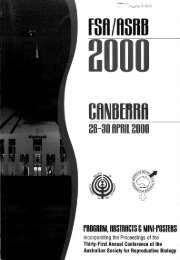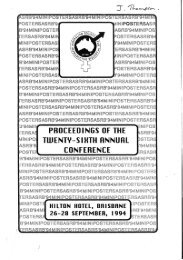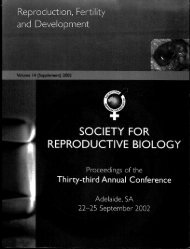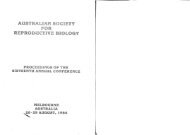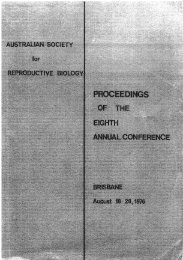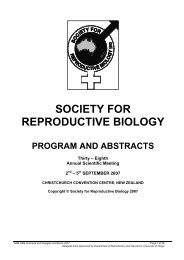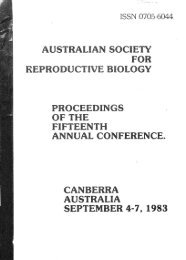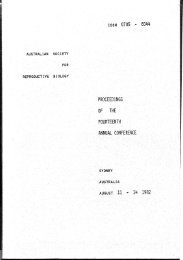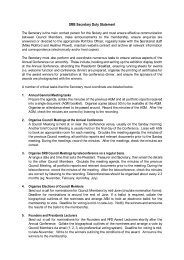N OCIETY' - the Society for Reproductive Biology
N OCIETY' - the Society for Reproductive Biology
N OCIETY' - the Society for Reproductive Biology
You also want an ePaper? Increase the reach of your titles
YUMPU automatically turns print PDFs into web optimized ePapers that Google loves.
humancowratsheepmouse102Ovarian steroid hormones and growth factors in <strong>the</strong> uterine control of early embryonicdevelopment in <strong>the</strong> tammar wallaby, Macropus eugenii.rat92%Cyrma M Hearn -and Marilyn B RenfreeDepartment of Zoology, University ofMelbourne, Parkville, Victoria 3052Embryonic diapause provides a powerful tool tounderstand <strong>the</strong> uterine control of early embryonicdevelopment. Whilst about 60 species of eu<strong>the</strong>rian, and30 species of marsupial exhibit diapause, <strong>the</strong> control isbetter understood in <strong>the</strong> tammar wallaby, Macropuseugenii, than in most o<strong>the</strong>r species. Under <strong>the</strong> influenceof a sucking young in <strong>the</strong> pouch, development of <strong>the</strong>tammar embryo in utero ceases completely at <strong>the</strong> 100cell. blastocyst stage. Diapause is maintained <strong>for</strong> at least11 months, during which time <strong>the</strong>re is no cell division orblastocyst growth. Despite <strong>the</strong> long period of arrest <strong>the</strong>reis no loss of embryonic viability. Most attention to datehas focused on <strong>the</strong> reactivation of corpus luteum andembryonic growth after <strong>the</strong> long arrest, with little focuson <strong>the</strong> mechanisms that control <strong>the</strong> onset of diapause.The aim of this study is to investigate <strong>the</strong> interactionsbetween ovarian hormones, uterine secretions and earlyembryonic growth as <strong>the</strong> blastocyst approaches andenters diapause.It is clear from work on eu<strong>the</strong>rian species that <strong>the</strong>re aremany growth factors, including. leukaemia-inhibitingfactor (LIF), epidermal-growth factor (EOF) and insulinlikegrowth factors (IOF-l & IOF-2), produced in <strong>the</strong>uterine secretions which may potentially regulateembryonic development. LIF is essential <strong>for</strong> growth of<strong>the</strong> early mammalian embryo (1). The expression of LIFin mice is maternally controlled by oestrogen andcoincides with blastocyst <strong>for</strong>mation (2). Similarly, inpigs (3) and cattle (4) oestradiol upregulates uterine LIFproduction. In rabbits by contrast, progesterone, notoestradiol, regulates LIF expression (5). Nei<strong>the</strong>r steroidinduces uterine LIF production in <strong>the</strong> skunk, but LIFmRNA is absent during diapause and high around <strong>the</strong>time of implantation (6).Our hypo<strong>the</strong>sis is that in <strong>the</strong> tammar <strong>the</strong> release ofoestradiol from <strong>the</strong> ovary, around <strong>the</strong> time of ovulation,induces <strong>the</strong> production of several growth factors,including LIF, which enhance cleavage and are essential<strong>for</strong> <strong>for</strong>mation of <strong>the</strong> early blastocyst. Over <strong>the</strong> next fewdays, without continued oestradiol stimulation and with atransient rise in progesterone post partum, growth factorproduction is downregulated, <strong>for</strong>cing <strong>the</strong> blastocyst intodiapause. Thus <strong>the</strong>re may be a direct interaction betweenovarian steroid' hormones and uterine" growth factorsecretion in initiation of diapause.human81%79%The endocrine changes and endometrial responses in <strong>the</strong>period between conception and <strong>the</strong> onset of diapause hasbeen poorly defined. Daily plasma samples were<strong>the</strong>re<strong>for</strong>e collected immediately after parturition until day10 after birth from females that retained <strong>the</strong>ir young(n=8), those who had <strong>the</strong>ir young removed at birth (n=8)and a group that carried a blastocyst in diapause (n=8).Plasma progesterone and oestradiol was measured byradioimmunoassay (RIA) as previously described (7),and a hormone profile <strong>for</strong> <strong>the</strong> three experimental groupsdefined. The genetic sequence of LIP in <strong>the</strong> tammar wasdetermined by nested polymerase chain reaction (PCR)using degenerate primers developed from conservedregions of known eu<strong>the</strong>rian species, and probesdeveloped from mouse and human LIP plasmids. The 38amino acid sequence of <strong>the</strong> peR product shows highhomology with previously described species (Table 1).The tammar LIP (tLIP) gene has a higher homology tohuman LIP than o<strong>the</strong>r eu<strong>the</strong>rian species. Using part of<strong>the</strong> tLIP sequence as a probe <strong>the</strong> expression of LIP inreproductive tissues and <strong>the</strong> early embryo will beaccurately determined by in situ hybridisation.Acknowledgments:We thank Prof. RR Behringer (Department of MolecularGenetics, MD Anderson Cancer Centre, Houston, Texas)<strong>for</strong> providing his expertise and laboratory facilities incloning tLIF. We are also grateful to Dr. D Hilton(Walter & Eliza Hall Institute, Victoria) <strong>for</strong> kindlyproviding <strong>the</strong> human and mouse LIF plasmids.References:1. Stewart CL (1994) Mol Reprod Dev 39:233-82. Bhatt H et al. (1991) Proc Natl Acad Sci 88:11408123. Yelich IV et al. (1997) Biol Reprod 57:1256-654. Reinhart KC et al. (1998) Mol Hum Reprod 4:301-3085. Yang ZM et al. (1996) Mol Reprod Dev 43:470-66. Hirzel DJ et al. (1999) Biol Reprod 60:484-927. Fletcher TP & Renfree MB (1988) JRF 83:193-200Table 1. A cross species comparison of homology between <strong>the</strong> tLlF protein to known sequencessheep pig tammar87% 92% 88%84%74% 82% 790/076%71% 76% 73%TEMPORAL AND TISSUE SPECIFIC EXPRESSION OF MOUSE KALLIKREIN (mKlk) GENES ANDIDENTIFICATION OF A NOVEL mKlk mRNA TRANSCRIPT DURING EARLY DEVELOPMENT INTHE MOUSE.C.S. Chan, M.B. Harvey and J.A. Clements .Centre <strong>for</strong> Molecular Biotechnology, School ofLife Sciences, Queensland University ofTechnology, Bnsbane 400l.IntroductionThe tissue kallikreins are a highly conservedmultigene family of serine proteases that act on adiverse range of substrates including growth factors,extracellular matrix (ECM) glycoproteins andproteinases and are important regulators of ECMdegradation and cell proliferation (1). They havebeen implicated in <strong>the</strong> uterine function of o<strong>the</strong>rspecies (2,3). The expression of five mKlk genesmKlk-1(tissue kallikrein), mKlk-3, mKlk-5, mKlk-9(epidermal growth factor binding protein) and mKlk21- was detected in <strong>the</strong> non-pregnant mouse uterus(4). The aim of this study was to elucidate <strong>the</strong>temporal and tissue specific expression pattern of<strong>the</strong>se five mKlks during early development.Materials & MethodsFertilised eggs, two-cell embryos, blastocysts, day7.5, day 9.5 and day 11 embryos were collected fromsix-week old, superovulated, mated female BCBFlmice. Uterine tissue was collected at correspondingdevelopmental stages. Total RNA was extracted andexpression of each mKlk and ~-actin was detected byper<strong>for</strong>ming reverse transcription (RT)-PCR, withgene specific primers, in <strong>the</strong> linear range to allowsemi-quantitative analysis. Sou<strong>the</strong>rn hybridisationwith gene-specific probes and/or DNA sequencingconfirmed <strong>the</strong> specificity of <strong>the</strong> PCR.ResultsThe ubiquitous "house-keeping" gene, ~-actin, wasexpressed in all samples, confirming <strong>the</strong> integrityand quality of <strong>the</strong> cDNA (Figure la). Positivecontrols (salivary gland) yielded mKlk products of<strong>the</strong> predicted size. All mKlks displayed distinctexpression patterns. We observed <strong>the</strong> expression ofmKlk-1 (Figure Ib), mKlk-3, mKlk-9 and mKlk-21(Figure lc) in <strong>the</strong> fertilised egg to <strong>the</strong> two-cell stage.Only mKlk-21 continued to be expressed until day7.5 of pregnancy. mKlk-9 expression reappeared atday 7.5 and was consistently detected until day 11(data not shown). mKlk-1 was again expressed in<strong>the</strong> embryo from day 9.5, with decreased levels byday 11 (Figure Ib). mKlk-5 was not detected in <strong>the</strong>embryo. In contrast, <strong>the</strong>re was no consistentexpression in <strong>the</strong> uterus of mKlk-1 until day 7.5which <strong>the</strong>n continued to day 11 (Figure Id). mKlk21 expression in <strong>the</strong> uterus displayed a similarpattern but was detected at much lower levels(Figure Ie). Of interest, a novel mKlk-21-likemRNA·I3 bp larger was detected in <strong>the</strong> uterus, buta.310243234b.6 ......3 : -~~~-~ ~.-~3c. M - + f.e. 2-cell blast d 7.5 d 9.5 i..ll.31 • : ~ _ __~ .,~w ->20194d.603383310e. 31. .lG4~~tG\.;~not in <strong>the</strong> embryo (Figures lc,e). mKlk-3, mKlk-5and mKlk-9 were not consistently expressed in <strong>the</strong>uterus ~e! th~ tiT~: 2-cell blast d 7.5 d 9.5 ~2019- _st.iU-_ _llllliIU1l1l'l- _ i'$!



